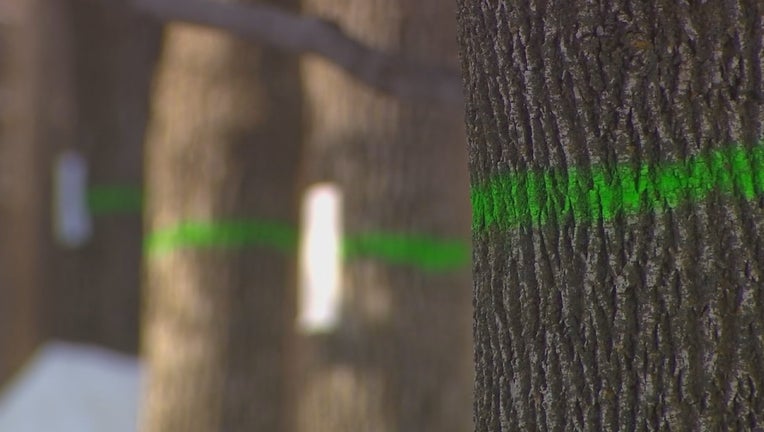3,000 trees to be removed in St. Paul due to emerald ash borer

Boulevard ash trees infected with the emerald ash borer are marked in green to be removed. (FOX 9)
ST. PAUL, Minn. (FOX 9) - Over the course of this year, neighborhoods all across St. Paul will look a lot different, perhaps even a bit stark.
Several thousand boulevard ash trees are now marked for removal, all victims of the emerald ash borer. Replacement is planned, but not for two years.
"Well it’s sad and inevitable," said Kevin Mummey, a resident in the Lexington-Hamline neighborhood.
When Mummey sees the green rings marking the ash trees set for removal, he thinks how different so many streets like his will look.
"It defines the flavor of a lot of St. Paul, really," said Mummey.
The canopy that is a calling card of so many St. Paul neighborhoods will soon disappear in big chunks.
"I mean there’s a certain amount of shade and peace that these trees offer this block, that I’ll miss, it’s going to look a little bit more stark than it has before," said Mummey.
St. Paul calls the process "structured removal." It involves taking out blocks of ash trees infested with the emerald ash borer. Some 3,000 are marked for removal this year.
A map on the city’s website shows the status of the ash trees in the area, whether they are in line for treatment or removal.
"Mixed emotions, kind of glad that St. Paul has a plan to replace them before they die of the ash borer," said Dan Kelly, a resident of the Highland Park neighborhood.
Cretin Avenue in Highland Park is also heavily marked. Only blocks away are streets that already look different with the open space of younger trees. Hoping to avoid that look, there’s been an effort in recent years to treat affected ashes and save whatever possible.
"I don’t think it’s a bad idea, actually in front of our house we’ve got an ash on the boulevard and it’s being treated," said Kelly. "It’s been treated for a couple years now."
At Mummey’s home on Hague Avenue his tree is being treated, too. In fact, the Lexington-Hamline neighborhood has aggressively pushed tree treatments and estimate 15 to 20 percent will be saved.
As for the marked trees, the city plans to remove all of them this year and replacement won’t come until 2023.
"You know what, maybe I’m not going to be the one to enjoy that canopy, but hopefully two generations down the road, it’ll be the same kind of canopy we are now, so we just have to think of the future," said Mummey.

